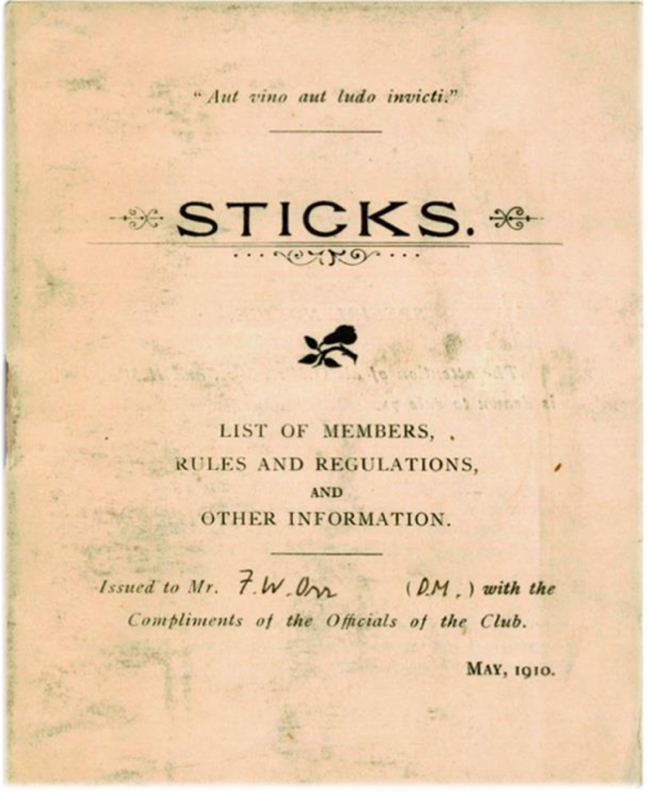- Chapter 12: Personalities in the Modern Game
- Intro
- CHAPTER 1: The Early Years 1891 to 1914
- CHAPTER 2: Standardization of the Rules. 1915 to 192
- CHAPTER 3: The "Golden " Years. 1920’s & 1930’s
- CHAPTER 4: THE EARLY CLUBS - PRE 1939
- CHAPTER 5: Personalities of the Early 20th Century.
- CHAPTER 6: THE POST WAR RECOVERY YEARS
- CHAPTER 7 : "THE PERENNIALS”
- CHAPTER 8: POST THE SECOND WORLD WAR YEARS
- CHAPTER 9: Rectory Park.
- Chapter 10: The Modern Game - The Last 50 Years
- CHAPTER 11: League Hockey
- Chapter 12: Personalities in the Modern Game
- Intro
- CHAPTER 1: The Early Years 1891 to 1914
- CHAPTER 2: Standardization of the Rules. 1915 to 192
- CHAPTER 3: The "Golden " Years. 1920’s & 1930’s
- CHAPTER 4: THE EARLY CLUBS - PRE 1939
- CHAPTER 5: Personalities of the Early 20th Century.
- CHAPTER 6: THE POST WAR RECOVERY YEARS
- CHAPTER 7 : "THE PERENNIALS”
- CHAPTER 8: POST THE SECOND WORLD WAR YEARS
- CHAPTER 9: Rectory Park.
- Chapter 10: The Modern Game - The Last 50 Years
- CHAPTER 11: League Hockey
3. CHAPTER 1: The Early Years 1891 to 1914
The Sutton Coldfield Hockey Club was formed in 1891 when some members of the cricket club, and others, feeling the need of some winter recreational activities, other than football, decided to form a hockey club and was the fourth club to be born in the Midlands.
The first games were played on the Meadow Platt in Sutton Park but in 1895 the Club moved to Four Oaks Park where on a better surface the play improved. In 1898 the Club returned to Sutton Park where they played on the Meadow Platt a good ground when dry but deplorable when wet and bumpy when it was very dry.
Forward play deteriorated whilst defences tended to become more robust. It is believed that official County Associations were not formed until 1904 though County matches were played from 1896 when five Sutton players represented Warwickshire in their first County fixture. They were Rev. A. Morley (Full back and first Captain of Warwickshire), S. Foster (Goal), Rev. A. E. R. Bedford, A. V. Jerome and G. Parkes (Forwards). Warwickshire won by 5 goals to 2.
At that time there were only three clubs in existence in the Midlands Playing the game. One of these was Edgbaston, so, different weekly opponents were relatively few in number.
The first ground was on the Meadow Platt in Sutton Park, a fairly good ground, though bumpy when dry, but very poor when wet. Changing facilities in the Park did not exist, so players had to change at home, which frequently involved long trek on foot or by bicycle. For visiting teams accommodation was arranged at premises in Park Road near the main gates:
With no regular attention to the surface the conditions generally in the Park, left a lot to be desired as far as hockey was concerned. In 1895 the club obtained a ground in Four Oaks Park, where, with the improved surface, better stick-work and more skillful hockey was possible and with more clubs coming into existence in the Midlands, fixtures were becoming more plentiful.
The move lasted only until 1898, when the club again returned to the Meadow Platt. The reasons for this are not known, though it is surmised the land may have been required for building operations or for some other purpose. With the return to the inferior surface in the park forward play again deteriorated and defense’s’ became more robust.
(Information acquired from the Hockey Museum - AKA THM's Collection Stores)
In a recent FIH-hosted webinar Curator, Mike Smith covered all manner of hockey history nuggets and fielded several questions along the way. Among these was, “What is the oldest rules book in the collection?”
A frantic scurry off camera – no mean feat in a collection of 70,000+ objects – and soon Mike was presenting to camera a very delicate and faded Hockey Association (HA) rule book from 1889.

County hockey was instated as early as 1896 but it was not until some years later that County Associations were formed. In Warwickshire's first match five Sutton players were included - Rev A. Morley (full back and captain), S. Foster (goal), Rev A.E.R. Bedford, A.V. Jerome, and G. Parkes, (forwards).
Little detailed information is available over the next ten years except that the game increased in popularity, and during the decade many more clubs were formed in the Midlands.
Early recollections of the writer, Norman Sharp born 15th April 1901 are that as a small boy who was a regular spectator in 1908, watching his father George Sharp playing hockey in Sutton Park for the Sutton Coldfield Hockey Club. It was perhaps natural that the club had quite a considerable spectator following as most of the 1st team were local clerics, magistrates, aldermen, councilors, solicitors and doctors. A fixture card of that year shows that two teams took the field each week, commencing with a practice game the first week in September and finishing in mid-April.
Fixtures included Lichfield, Coventry, Small Heath, Chester Road, Burton Winshill, Olton, Orientals, Harborne, Walsall, Camp Hill Old Edwardians, Cheltenham, Bournville, Pickwick, and Aldridge.
In 1910 the Club moved again this time to the quiet and pleasant surroundings of the cricket ground at Rectory Park where the Club has been ever since. The better surface of the new ground encouraged a higher standard of stick play and by 1913 the Club was recognised throughout the Midlands for its skillful hockey. Representing the First Eleven in those days were players of such caliber as E. B. Crockford (England, Midlands and Warwickshire), L. C. Crockford and R. M. Evans (both Midlands and Warwickshire) and W. G. Denston and W. Pollock (both Warwickshire).
Quite a number of the members were also connected with the Sutton Coldfield Cricket Club to whom approaches were at this time being made for the use of a pitch at the Rectory Park. There were several advantages to be gained from such a move, perhaps one of the most important being that the ground was not trampled over by the general public during the week, and by the use of the cricket club roller (and horse, for there were no mechanized aids to groundwork then in existence). The improved playing surface enabled a higher standard of hockey to be reached over the next few years.
The move was made in 1910, though at that time it must not be assumed all was milk and honey. For instance, the old thatched pavilion, which, though picturesque, was not the ideal place in which to change as there was no running water supply (for cricket teas etc. it had to be wheeled in a tub from Riland Road), nor was there any lighting or heating of any kind - essential in the cold dark winter evenings.
S. A. Taylor JP was the first elected President of the Sutton Coldfield Hockey Club and carried out all the Club’s management functions. However, it is unfortunate that very little information about Taylor has been found, nor whether or not he was a player or in what capacity he qualified for the Presidency. Nevertheless, it is understood he must take a lot of the credit for the work and interest he took in the club during those early days. He remained President until his death twenty-three years later in 1914 and had held office since the Club was formed.
Accordingly, the Royal Oak became the club's headquarters where after match facilities were available for visiting teams in comfort. The Royal Oak was situated at the corner of Mill St and Coleshill St where the Vesey Gardens now exist, and was of considerable historic interest. With motorised transport not yet in general use players had to foot-slog the journeys to and from the ground, whilst the home team mostly dressed in their own homes.
Sutton Coldfield Hockey Club 1908- 09 Season
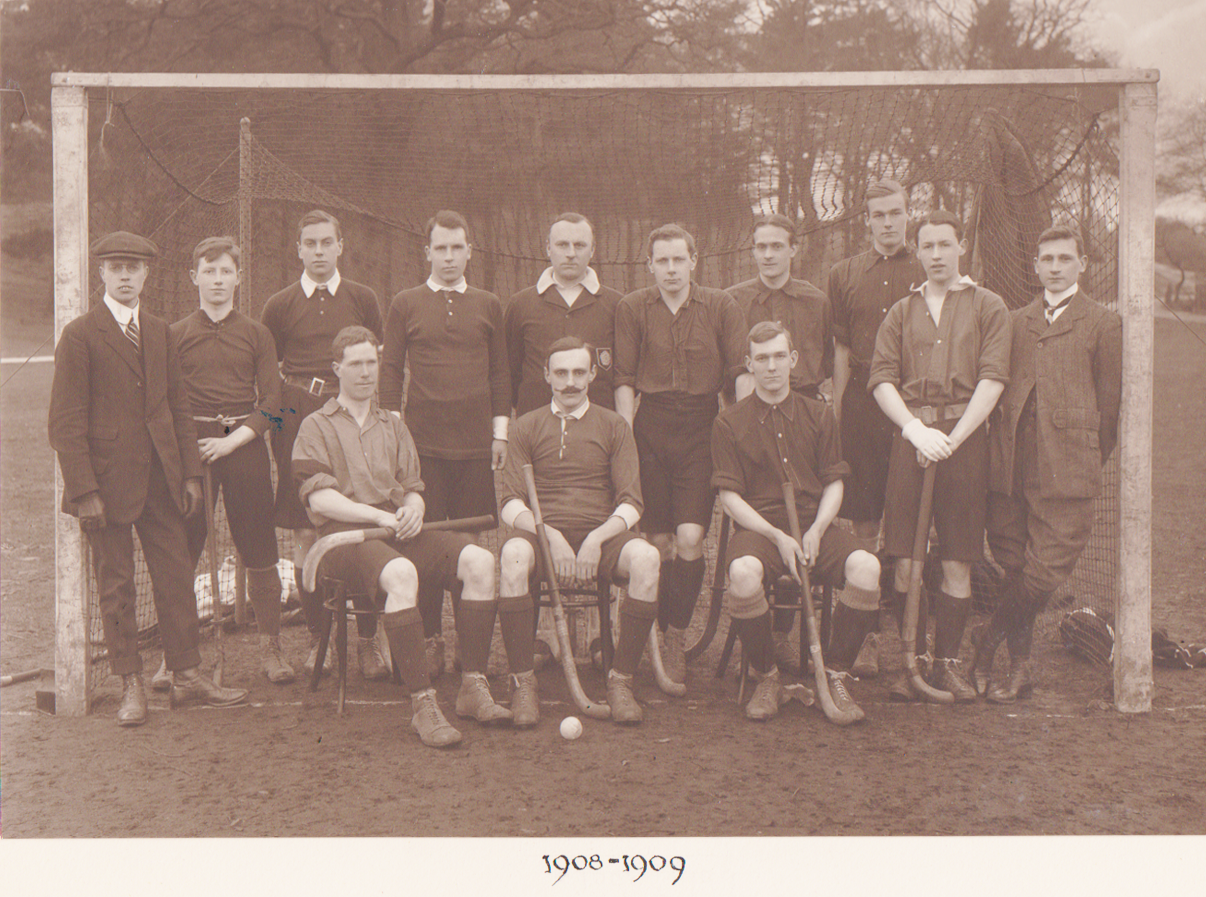
No players names were ever recorded.
Extracted from The Hockey Museum
A document on the existence of a secretive gentlemen’s hockey club in London in May 1910. Particularly amusing was the description of a bizarre initiation ceremony for new members and the Club’s Latin motto which translates as, “Never defeated by wine or in a game”.
It would seem that hockey and imbibing have always gone hand in hand.
Sutton Coldfield Hockey Club 1913-14 Season
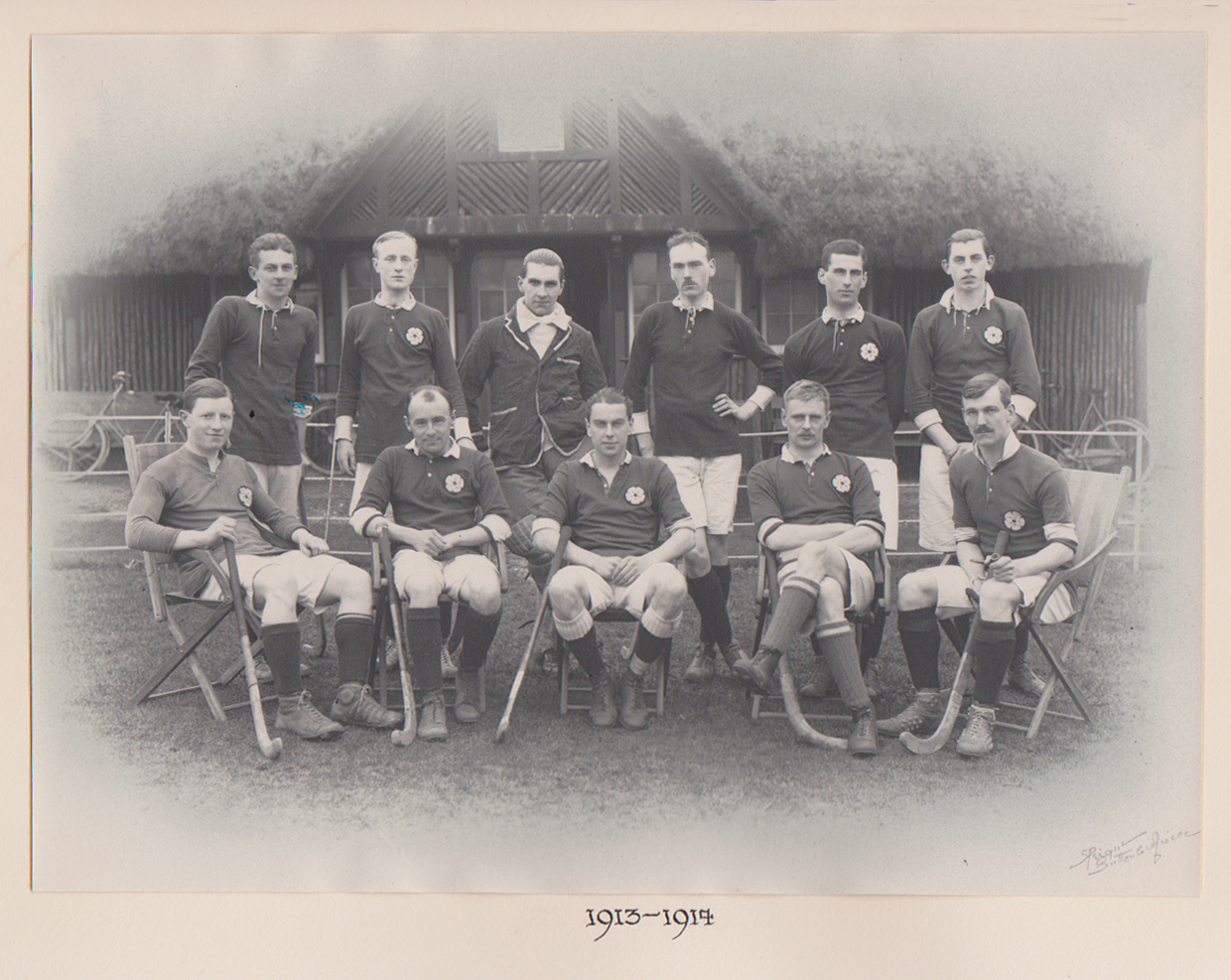
Obituaries
Tribute to Percival Allen Grove
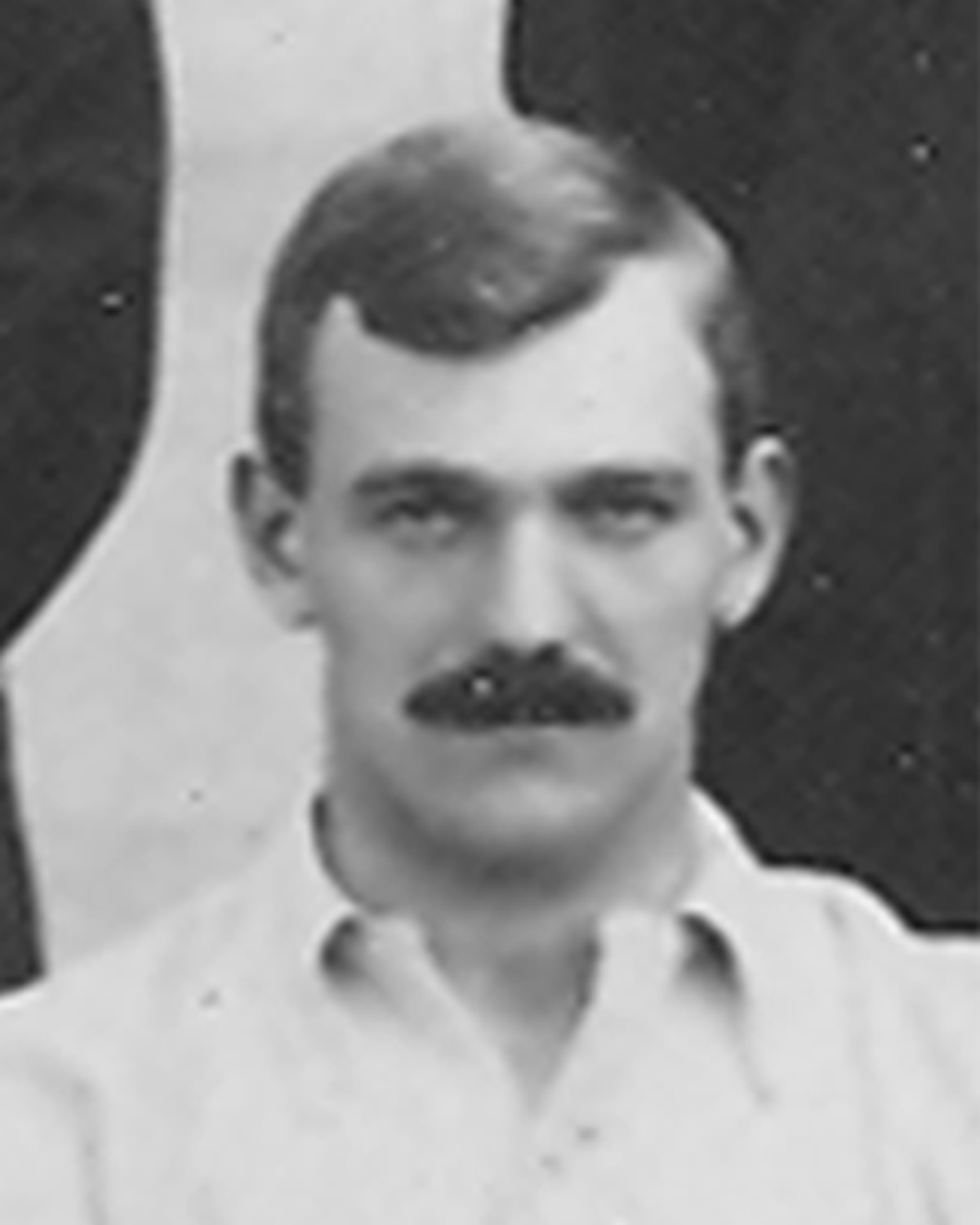 Percival Allan Grove was born in Sutton Coldfield on the 29th September 1888 and was the eldest son of Allen and Elizabeth Whilock Grove of ‘Copsewood’, Tudor Hill, Sutton Coldfield.
Percival Allan Grove was born in Sutton Coldfield on the 29th September 1888 and was the eldest son of Allen and Elizabeth Whilock Grove of ‘Copsewood’, Tudor Hill, Sutton Coldfield.
Prior to the war the family lived at The Cedars, Doe Bank, Lichfield Road, Four Oaks, his father was a partner in Messrs.’ Crockford, Grove and Sons of Bull Street Birmingham. His grandfather on his mother’s side was Mr. R W Simkin the penultimate Warden of Sutton Coldfield in 1879-81.
Percival Allan Grove was born in Sutton Coldfield on the 29th September 1888 and was the eldest son of Allen and Elizabeth Whilock Grove of ‘Copsewood’, Tudor Hill, Sutton Coldfield.
Percival was affectingly known as Percy and was educated at Bishop Vesey Grammar School between 1899 and 1905. He was awarded the Victor Ludorum at school in 1905,
He became a chartered accountant with Harrison, West & Ledsam at Waterloo Street, Birmingham.
Percy was married to the sister of a Captain Russell Turner (Old Veseyan), who was killed in the 3rd Battle of Ypres on the 4th October 1917. His brother Oswald Harry Grove also served in the army
Percy joined both the Sutton Coldfield Hockey Club and the Cricket club in 1906 and it was reported that he was a useful bowler who took 7 wickets for 14 runs at Rectory Park against Yardley and was a very skillful full back on the hockey pitch.
Percy enlisted with the 1st City Battalion Royal Warwickshire Regiment – 14th Battalion, ‘12’ Section, ‘111’ Platoon, ‘A’ Company in August 1914 - Private 14/1209. (Which also included Old Veseyans, Philip Evans and Russell Turner and Jack Caswell were in the same Platoon but in ‘10’ Section). Percy was commissioned Second Lieutenant on the 9th September 1915 into the Royal Warwickshire Regiment 1/5th Battalion.
The 1/5th and 1/7th Warwicks (143rd Brigade, 48th (South Midland) Division) manned the line southeast of Hébuterne (between Gommecourt and Serre). There was to be no attack on this front on the 1st July, but the Battalions were expected to draw attention to themselves prior to that day as a diversion to the main attacks. The Battalions were expected to carry out frequent raids that cost lives, but did succeed in drawing the only German reserves (2nd Guards Division) in the area, prior to the 1st July, to the front opposite Hébuterne.
The preliminary British bombardment all along the front, which started on the 24th June 1916, drew heavy retaliatory German shelling. On the 1st July the 1/5th Warwicks released smoke along their front and watched the London Scottish advance through it for their diversionary attack on Gommecourt, on the Somme
2nd Lt. P A Grove was badly wounded in several places by a ‘bomb’ on the 1st July. He entered the 2nd British Red Cross Hospital in Rouen at 11am on the 5th July and died of wounds at 4pm.
The Battalion was relieved on the 4th July and after suffering 13 days of shelling and raiding, they had only 75 casualties, but one was Percy who was aged 27
Percy was buried at St Sever Cemetery, Rouen, France. Plot A; Row 3; Grave 8, and a letter from the Matron at the hospital in Rouen to his parents reported that: “Percival’s funeral took place at 2pm on the 6th July. The hymns 277 and 438 were sung, together with the Nunc Dimittis.
A large cross from his father and all his loved ones and two wreaths, from Matron and nursing staff and Sergeant Major and orderlies were placed upon the coffin. He had a full and impressive military funeral and all was done beautifully and reverently, as at home”.
Percy was awarded the Victory and British Medals RWR/OFF/150 page 224 and is commemorated on the Holy Trinity Church Memorial Plaque and his name is recorded on the Sutton Coldfield Memorial, in King Edwards Square
Peter R.G. Bell
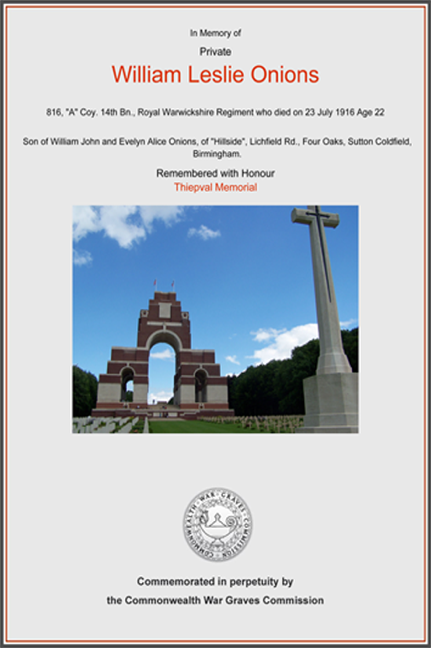
William Leslie had a younger sister Ethel C.S Onions born in 1895 and a younger brother Raymond Harry, born in 1904. William was educated at King Edwards School Birmingham.
On leaving school he was articled to Messrs Sharp, Parsons & Co, Chartered Accountants of 120 Colmore Row, Birmingham.
William played hockey in Rectory Park for Sutton Coldfield Hockey Club and was playing for the Clubs 2nd team in the 1912-13 season and was elected 2nd team captain for the 1913-14 season.
The Birmingham Daily Post published on the 2nd September 1914 records that W.L. Onions of Hillside had signed up the previous day, the 1st September 14 as an applicant for the “City Battalion” at its formation having registered his name at the “Daily Post Office”. Later to become Private William Lesley Onions, No. 816 in the Royal Warwickshire Regiment. William served in France and Flanders with “A” Company in the 14th Battalion of the Royal Warwickshire Regiment and was reported missing on 23rd July 1916 although his death was not confirmed until the December 16, that he had been killed in action on 23 July 1916 aged 22.
The Sutton Coldfield News of the 30th December 1916 reported that William was killed during the Battle of the Somme and has no known grave.
He is commemorated on the Thiepval Memorial and his name is recorded on the St James Church list and is also recorded on the Sutton Coldfield Memorial, in King Edwards Square. He was awarded the Victory and British Medals.
Peter R.G. Bell


